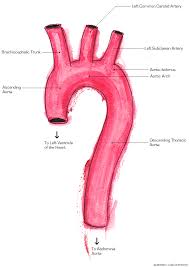
记忆方法
将“aorta”想象为一个“ ao ”字母形状的主动脉,它从心脏出发,像是“a”字形的血管。这样可以将单词的形状和其作为主要大动脉的含义结合起来,帮助记忆。
以上内容由AI生成, 仅供参考和借鉴
中文词源
aorta 大动脉
来自拉丁语。来自air的词根义,举起,升起。指心脏大动脉。
英语词源
- aorta
-
aorta: see artery
- aorta (n.)
- 1570s, from Medieval Latin aorta, from Greek aorte, term applied by Aristotle to the great artery of the heart, literally "what is hung up," from aeirein "to lift, heave, raise," which is of uncertain origin; related to the second element in meteor. Used earlier by Hippocrates of the bronchial tubes. Related: Aortal; aortic.
权威例句
- 1. The abdominal aorta is normally smaller than the thoracic aorta.
- 腹主动脉一般比胸主动脉小.
- 2. Sudden deceleration may also result in shearing injury to the intima of the aorta.
- 突然减速也可能造成主动脉内膜的剪式裂伤.
- 3. The aortic valve is found between the left ventricle and aorta.
- 主动脉瓣位于左心室和主动脉之间.
- 4. All patients received aortic valve and ascend aorta replacement.
- 均在体外循环下行主动脉瓣和升主动脉置换.
- 5. The blood can dissect up or down the aorta.
- 血液可沿主动脉向上或向下剥离动脉.